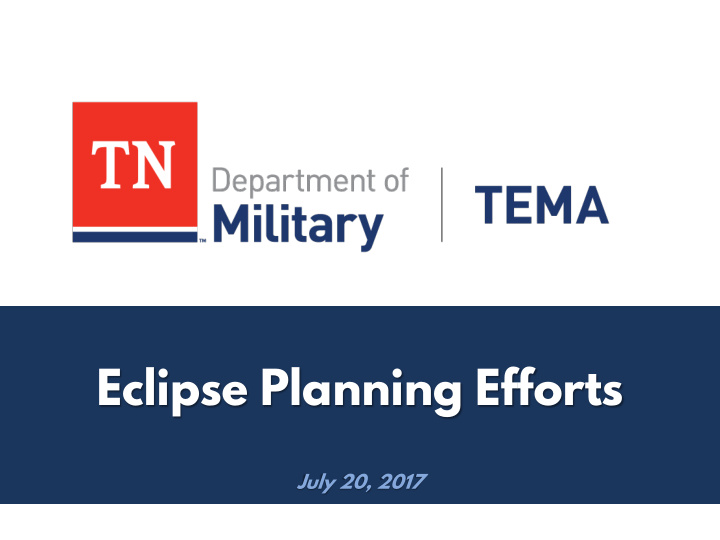



Eclipse Planning Efforts July 20, 2017 Updated: 8/15/2016
Purpose – Provid ide Situ ituatio ional l Aware reness on th the Eclips lipse – Over ervi view ew of the e State’s 2017 Sola lar Eclips lipse Coordin dinati tion Pla lan
2017 Solar Eclipse Coordination Plan
Goal & Priorities (Chapter 1) • Goal al – The goal of the 2017 Solar Eclipse Coordination Plan is to support safety within Eclipse viewing areas by encouraging partners to prepare in advance for potential emergency situations, by making State emergency support resources available when possible, and by documenting actions of partner agencies for situational awareness. • Priori ritie ties – Address Life Safety Needs – Support Local Governments and Resource Requests – Support Safe Movement along our Transportation System – Ensure Coordination and Communication among Local, State, & Federal Partners
Threat Identification (Chapter 2) First step of the Emergency Planning Process is to identify the Threat(s) – Ha Hazard • A hazard itself is usually the threat – Easy to identify the threat, – So we usually skip this step – Spe Special Ev Event • An special event itself is not usually the threat – Sometimes harder to identify the threat, – So we need to formally address this step
Primary Threat (Chapter 2) Prim rimary th thre reat to to Tennesse ssee: – The e poten ential for or Maj ajor or Di Disruption ons and and L Life-Threa eaten ening A g Acciden ents o on our Trans anspor ortat ation S on Systems
Associated Threats (Chapter 2) The event’s associated threats rel elated to to the Transportation System: Disrupted Emer erge gency Ser ervice Veh ehicle e Res esponses – Strand anded Mot otor orists – Disru srupte ted Schoo hool Bu Bus & Scho hool ol Pic Pickup Trans nsportat ation on – The event’s associated threats not rel elated to to Transportation System: Attack at at Mas ass Gat athe hering ngs – Com ommun unication on Disrup uption ons on on Cell Phone hones – Issue ues at at Mas ass Gat athe hering ngs (Overdose ses, s, Fights, ts, Crowd Contr trol) – Sun n Blind ndne ness Issues, Heat Exhau austion, on, & Non-Tran anspor ortation n – Accid idents/In Incid idents requir irin ing Medic ical Assis istance Inc ncreased 911 Cal alls due to o Ind ndividua uals unaw naware of of Ec Eclipse – Inc ncreased Boat oat & Wat ater Accidents – Air Airspace Is Issues – Sol olar Ene Energy Devices –
Stakeholder Involvement (Chapter 3) Second step of the Emergency Planning Process is to identify who needs to be involved. Core State Planning Team for Eclipse Safety Partners for Eclipse Safety
Planning Considerations (Chapter 2) A. Eclips lipse Timin ing
Planning Considerations (Chapter 2) A. Eclips lipse Timin ing
Planning Considerations (Chapter 2) B. Incre rease se in in Visit isitors & Mas Mass Gath therin rings 360,00 360 000 to to 1,440 40,000 00 vi visitor ors based ed on on model el esti stimate tes –
Planning Considerations (Chapter 2) B. Incre rease se in in Visit isitors & Mas Mass Gath therin rings
Planning Considerations (Chapter 2) C. Prima mary Concer ern Factor for Total & Pa Partial Eclips pse Area eas To Total Eclipse se (44 44 counti ties) es): significant increase in visitors and mass gathering events – Parti Pa tial Eclipse (51 51 counti ties) es): lack of awareness of the eclipse – West Regi We egion: 93-99.9% obscuration • Middl iddle Regi egion: 95-100% obscuration • Eas East Regi egion: 95-100% obscuration •
Planning Considerations (Chapter 2) C. Primary Concern rn Fa Factor for or Tot otal al & Partial Eclipse pse Area eas
Planning Considerations (Chapter 2) C. Primary Concern rn Fa Factor for or Tot otal al & Partial Eclipse pse Area eas
Planning Considerations (Chapter 2) C. Primary Concern rn Fa Factor for or Tot otal al & Partial Eclipse pse Area eas
Planning Considerations (Chapter 2) D. Trans nspor ortat ation on Chok hoke Points ts
Planning Considerations (Chapter 2) D. Trans nspor ortat ation on Chok hoke Points ts
R & R: Essential Information Collection (Chapter 3) Esse ssentia tial Ele lements ts of of Inf nfor ormat ation on (EEI (EEI): the key pieces of information needed to help support decision-making before and during the event based on the threats. – Status of Eclipse Timing by Areas: TEMA – Status of Weather Conditions: NW NWS – Status of Highway Flow: TDOT OT & & THP HP – Status of Highway Accidents: TD TDOT & & TH THP – Status of Stranded Motorists: TDOT OT & & THP HP – Status of Mass Gathering Events: State Pa Parks, T Touri rism sm, & & TEMA MA – Status of Emergency Vehicle Flow: THP HP & & Healt lth – Status of Lakes & Waterway Incidents: TWRA RA – Status of Local Resource Requests: TEMA MA – Status of School Closures & Bus Transportation: Educ ucat ation on
R & R: Emergency Support Coordination (Chapter 3)
Three Deliverables – Coor ordinat nation on Plan (du due b by J July ly 19 th ) – Incid ident Actio tion Pla lan (d (due e by Aug ugust ust 14 th ) ) – Table bleto top Exercis ise (on on Jul uly 26 th )
Recommend
More recommend